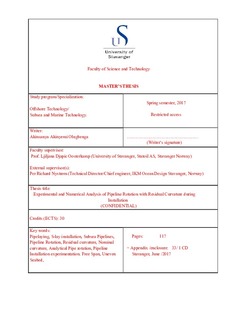| dc.description.abstract | In the oil and gas industry, subsea pipeline plays a very important role in the transportation of the crude oil between subsea production system (SPS) components and from seabed to the offshore platform/facility, or from an offshore field to an onshore facility for processing, thus serving as in-field line and trunk line (export and import transportation line) respectively. Hence its design, fabrication and installation are very vital to the successful operation of any subsea infrastructure. In the past, detail assessment of pipeline installation methods and design has been performed and documented in several literatures. However, following the decline in the price of oil and gas and the inclination of the exploitation of oil and gas production towards deep and deeper water, it becomes imperative to reevaluate all aspects that made up of subsea field development in terms of design, construction and operation, in order to reduce the overall project cost, while meeting all the technical challenges associated with subsea field development in deep water.
In lieu of this, for pipeline, being a critical aspect of subsea development project, additional engineering effort is required to minimize the cost of pipeline installation, since its material and installation together can make up to 85% of the total pipeline budget (Bai et al. 1999). To achieve this, focus is given to the utilization of pipeline rotation during installation via optimization of the use of pipeline residual curvature, in meeting the technical challenges associated with pipeline free span and in minimizing the cost that comes with mitigations via material dumping and other span supports as well as understanding pipeline rotation phenomenon in the case of inline structure installation such as Tees, Wyes, Connectors, thus saving operation time and reducing the cost of pipeline intervention on the seabed.
This Thesis work, concentrate on the validation of the numerical analysis of estimating pipeline rotation during S-lay, using an experimental test on pipeline rotation, based on this, parametric studies are carried out. Also an experimental test is performed to determine the value of residual strain and curvature length required to induce a pipeline rotation of above 90degree. Additional experimental test is performed to establish the operational principle of conforming pipeline to uneven seabed using residual curvature, this is considered relevant as residual curvature can be adopted in solving the technical challenges that come with installation of pipeline by S-lay method on uneven seabed, since such pipeline are subjected to bending moments, vortex induced vibration (VIV) and so on, as a result of free span.
To meet the objective of this study, both experimental and numerical approaches were adopted. First, experimental tests were performed using an already existing model test set-up components of a real-life scenario is adopted, this set-up components comprises of all the important installation vessel parameters that are used in real life S-lay installation operation of pipeline. These components include the model stinger and associated rollers, the top tension system, bottom horizontal tension system and model pipe of 10mm for simulating the S-shape and nominal curvature. In addition to the existing component, wooden stands, with seabed features, are constructed and used to simulate the uneven seabed. The experimental test is performed by introducing several pre-bends of different residual strains and curvature length on the model pipeline for the cases of rotation test and free-span test. The pipe paying out operation was simulated by pulling the model pipeline at the bottom while measuring the angle of rotation and the horizontal force for the rotation test and change in span between the contact point and the depth from seabed to mid span for the case of free-span. Also, the free span test includes simulation of additional measures such as introduction of local weights and their effect in the suppressing pipeline free span. Afterward numerical analyses were performed to quantify the pipeline rotation, using commercial finite element software, ORCAFLEX. In the numerical analysis, a beam model of the pipeline is built in the
software using the same properties of the model test rig (listed subsequently in the thesis work), the pipe properties, inline structure and boundary conditions (BC). Then parametric studies are performed by varying several parameters, such as pre-define residual curvatures length and plastic strain, which affect the value of the rotation, with major focus on the rotation phenomenon at the touch down point (TDP). | nb_NO |
